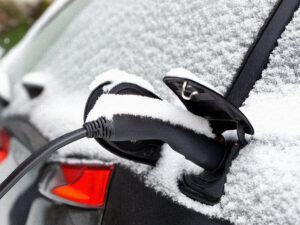If you manage a fleet that experiences all four seasons, you’re well aware that winter weather presents unique challenges, impacting both driver safety and fuel efficiency. Whether you’re managing traditional gas-powered vehicles or considering an electric fleet, it’s crucial to understand how cold temperatures affect performance. The U.S. Department of Energy notes that gasoline vehicles can see a 15-24% MPG decrease at 20°F. While vehicles with an electric powertrain are generally more efficient, they also experience range loss in winter—around 20% in freezing temperatures, according to a 2025 Recurrent study. 
However, electric vehicles (EVs) offer distinct advantages for winter fleet operations. Unlike their combustion engine counterparts, EVs provide:
- Rapid Cabin Heating: forget idling to warm up. EVs deliver instant cabin heat, keeping drivers comfortable from the start of their routes.
- Efficient Defrosting: clearing icy windshields is quick and easy, improving visibility and ensuring your fleet gets on the road safely and efficiently.
While those are real quality-of-life perks for your drivers, minimizing EV range loss in winter remains essential for optimal fleet performance. Here are practical tips for fleet managers to maximize EV efficiency during winter months:
Vehicle Selection & Range Expectations
When selecting EVs for your fleet, prioritize models equipped with heat pumps and preconditioning capabilities, especially if operating in colder climates. These features can significantly improve EV range in winter—potentially by up to 10%. During driver training, it’s important to address the EV range drop in winter, explaining that reduced range is perfectly normal in cold temperatures. By reassuring drivers that there are no problems with their vehicles and no long-term impacts to battery health, you’ll help reduce winter range anxiety.
Optimizing Energy Use
While EV cabin heating systems are typically energy-efficient, their energy consumption does contribute to range reduction during operation. Implement the following strategies to mitigate heating-related range loss and optimize driver focus.
- Vehicle Pre-Heating: encourage drivers to pre-heat the cabin while the EV is still connected to the charger. This leverages grid power instead of depleting the battery.
- Smart Temperature Management: advise drivers to set cabin temperatures moderately and utilize seat and steering wheel warmers (if available), which consume less energy than the primary cabin heater.
Prep to Reduce Cold Weather Charging Time
These strategies can help your fleet streamline winter EV charging and maximize driver safety during inclement weather.
- Indoor Parking: utilize garages or carports whenever possible. Indoor parking helps maintain battery temperature and prevents snow and ice accumulation, simplifying vehicle preparation.
- Preconditioning for DC Fast Charging: cold temperatures can make a significant impact on DC fast charging speeds, luckily engineers have solved how to keep EV batteries warm in winter. Train drivers to utilize the preconditioning feature (available in many EVs) to warm the battery to optimal charging temperature before arriving at a DC fast charging station. This minimizes charging downtime.
- Overnight Charging (at Depot): for fleets that charge overnight at a central depot, temperature fluctuations typically have less impact on charging speeds. However, it’s important for your facilities team to keep EV charging spots clean from snow and ice to prevent falls and ensure charging cables are easily accessible.
Remember, EV Winter Range Reduction is Only Temporary
By implementing these strategies and educating your drivers, you can confidently manage any EV range loss in winter, maintaining your fleet efficiency and driver satisfaction. Remember, the adjustments are temporary, and the benefits of driving electric will return in full force as temperatures rise.
For the latest Inspiration updates, follow us on LinkedIn.
